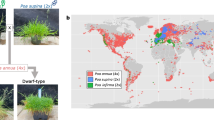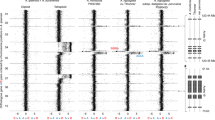Abstract
Paspalum plicatulum is a perennial rhizomatous grass with natural diploid and polyploid cytotypes. In this study, we investigated the occurrence of sequence polymorphisms arising immediately after genome autoduplication in this species. Two mixoploid plants (4C and 7D) were previously obtained through colchicine treatment of seeds generated by open pollination of a diploid plant (H14-2x). Diploid and tetraploid sectors from both mixoploids were dissected to generate two ploidy series (4C-2x/4C-4x and 7D-2x/7D-4x). Molecular fingerprints were generated from the maternal plant H14-2x, both ploidy series (4C-2x/4C-4x and 7D-2x/7D-4x), and a tetraploid plant (C1) produced by selfing 7D-4x. Our results indicate that immediately after polyploidization P. plicatulum suffers genetic rearrangements affecting ~28–38 % of the genome. Band gain and loss were equally prevalent at a statistically significant level. At least 5.62 % of the genome experimented recurrent genetic variation in a non-random basis with a confidence of 94.88 %. A significant proportion of novel bands (36 out of 195; 18.4 %) was detected in the C1 tetraploid plant. Half of these bands were not amplified in either H14-2x or 7D-4x, while the remainders were present in H14-2x but absent in 7D-4x. Our results indicate the occurrence of a considerable number of genetic changes in P. plicatulum immediately after polyploidization, some of which were recurrently detected in different independent events. Moreover, we confirmed that after polyploidization, lost ancestral alleles were spontaneously recovered in further generations, a phenomenon previously reported by other research groups.


Similar content being viewed by others
References
Aversano R, Caruso I, Aronne G, De Micco V, Scognamiglio N, Carputo D (2013) Stochastic changes affect Solanum wild species following autopolyploidization. J Exp Bot 64(2):625–635
Blakeslee AF, Avery AG (1937) Methods of inducing doubling of chromosomes in plants by treatment with colchicine. J Hered 28:393–411
Bonin A, Bellemain E, Bronken Eidesen P, Pompanon F, Brochmann C, Taberlet P (2004) How to track and assess genotyping errors in population genetics studies. Mol Ecol 13:3261–3273
Chen ZJ, Ni Z (2006) Mechanisms of genomic rearrangement and gene expression changes in plant polyploids. Bioassays 28:240–252
Comai L, Tyagi AP, Winter K, Holmes-Davis R, Reynolds SH, Stevens Y et al (2000) Phenotypic instability and rapid gene silencing in newly formed Arabidopsis allotetraploids. Plant Cell 12:1551–1568
Dellaporta SL, Wood J, Hicks JB (1983) A plant DNA minipreparation. Version II. Plant Mol Biol Rep 1(1983):19–21
Feldman M, Liu B, Segal G, Abbo S, Levy AA, Vega JM (1997) Rapid elimination of low-copy DNA sequences in polyploid wheat: a possible mechanism for differentiation of homoeologous chromosomes. Genetics 147:1381–1387
Liu B, Brubaker CL, Mergeai G, Cronn RC, Wendel JF (2001) Polyploid formation in cotton is not accompanied by rapid genomic changes. Genome 44:321–330
Lolle SJ, Victor JL, Young JM, Pruitt R (2005) Genome-wide non-Mendelian inheritance of extra-genomic information in Arabidopsis. Nature 434:505–509
Madlung A, Masuelli RW, Watson B, Reynolds SH, Davison J, Comai L (2002) Remodeling of DNA methylation and phenotypic and transcriptional changes in synthetic Arabidopsis allotetraploids. Plant Physiol 129:733–746
Martelotto LG, Ortiz JPA, Stein J, Espinoza F, Quarin CL, Pessino SC (2007) Genome rearrangements derived from autopolyploidization in Paspalum sp. Plant Sci 172:970–977
Mecchia MA, Ochogavía A, Selva JP, Laspina N, Felitti S, Martelotto LG et al (2007) Genome polymorphisms and gene differential expression in a ‘back-and-forth’ ploidy-altered series of weeping lovegrass (Eragrostis curvula). J Plant Physiol 164:1051–1061
Newcombe RG (1998) Two-sided confidence intervals for the single proportion: comparison of seven methods. Stat Med 17:857–872
Ortiz JPA, Pessino SC, Leblanc O, Hayward MD, Quarin CL (1997) Genetic fingerprinting for determining the mode of reproduction in Paspalum notatum, a subtropical apomictic forage grass. Theor Appl Genet 95:850–856
Osborn TC, Pires JC, Birchler JA, Auger DL, Chen ZJ, Lee H-S et al (2003) Understanding mechanisms of novel gene expression in polyploids. Trends Genet 19:141–147
Ozkan H, Levy AA, Feldman M (2001) Allopolyploidy-induced rapid genome evolution in the wheat (Aegilops–Triticum) group. Plant Cell 13:1735–1747
Ozkan H, Tuna M, Galbraith DW (2006) No DNA loss in autotetraploids of Arabidopsis thaliana. Plant Breed 125:288–291
Parisod C, Holderegger R, Brochmann C (2010) Evolutionary consequences of autopolyploidy. New Phytol 186:5–17
Rohlf FJ (2002) NTSYSpc: numerical taxonomy system, version 2.1. Exeter Publishing, Setauket
Salmon A, Ainouche ML, Wendel JF (2005) Genetic and epigenetic consequences of recent hybridization and polyploidy in Spartina (Poaceae). Mol Ecol 14:1163–1175
Sartor ME, Quarin CL, Espinoza F (2009) Mode of reproduction of colchicine-induced Paspalum plicatulum tetraploids. Crop Sci 49:1270–1276
Shaked H, Kashkush K, Ozkan H, Feldman M, Levy AA (2001) Sequence elimination and cytosine methylation are rapid and reproducible responses of the genome to wide hybridization and allopolyploidy in wheat. Plant Cell 13:1749–1759
Song K, Lu P, Tang K, Osborn TC (1995) Rapid genome change in synthetic polyploids of Brassica and its implications for polyploid evolution. Proc Natl Acad Sci USA 92:7719–7723
Tayalé A, Parisod C (2013) Natural pathways to polyploidy in plants and consequences for genome reorganization. Cytogenet Genome Res 140(2–4):79–96
Vos P, Hogers R, Bleeker M, Reijans M, Van de Lee T, Hornes M et al (1995) AFLP: a new concept for DNA fingerprinting. Nucl Acids Res 23:4407–4414
Williams JGK, Kubelik AR, Livak KJ, Rafalski JA, Tingey SV (1990) DNA polymorphisms amplified by arbitrary primers are useful as genetic markers. Nucl Acids Res 18:6531–6535
Wilson EB (1927) Probable inference, the law of succession, and statistical inference. Journal of the American Statistical Association 22:209–212
Acknowledgments
This research was supported by Agencia Nacional de Promoción Científica y Tecnológica (ANPCyT), Argentina (Projects PICT 2007-00476 and PICT 2011-1269), and Consejo Nacional de Investigaciones Científicas y Técnicas (CONICET), Argentina (Project PIP No. 11220090100613). M. Sartor is a CONICET postdoctoral fellow, and F. Espinoza, C. Spampinato, and S. Pessino are CONICET research staff members.
Author information
Authors and Affiliations
Corresponding author
Rights and permissions
About this article
Cite this article
Weihmüller, E., Beltrán, C., Sartor, M. et al. Genetic response of Paspalum plicatulum to genome duplication. Genetica 142, 227–234 (2014). https://doi.org/10.1007/s10709-014-9769-2
Received:
Accepted:
Published:
Issue Date:
DOI: https://doi.org/10.1007/s10709-014-9769-2




